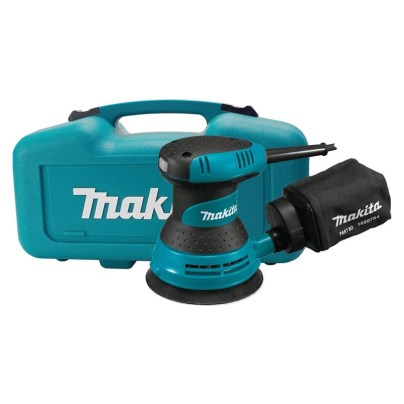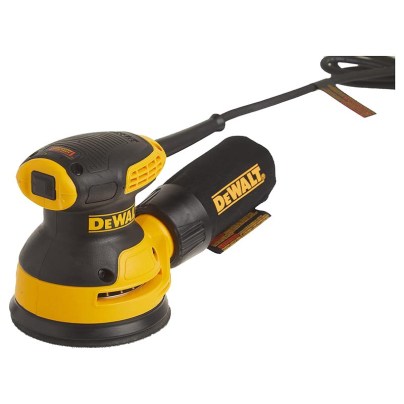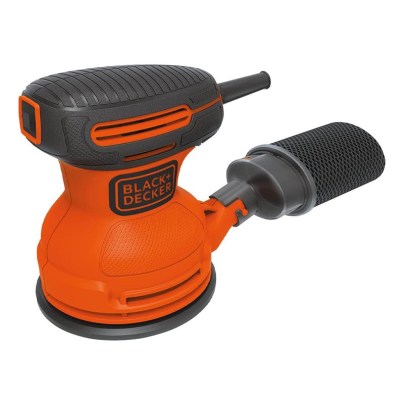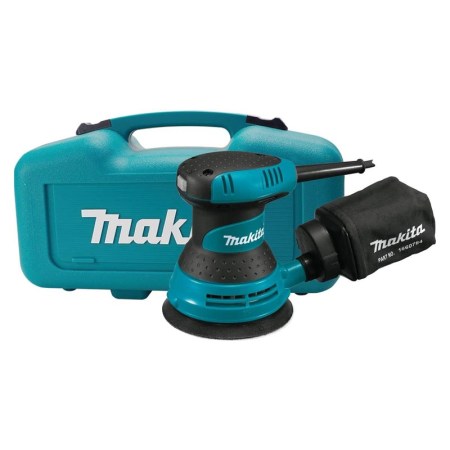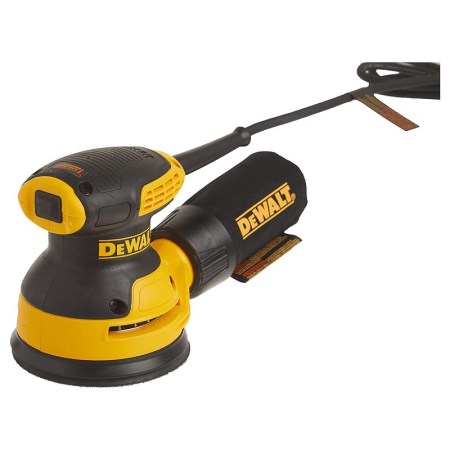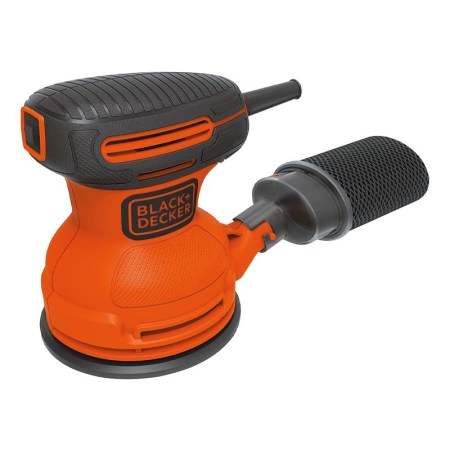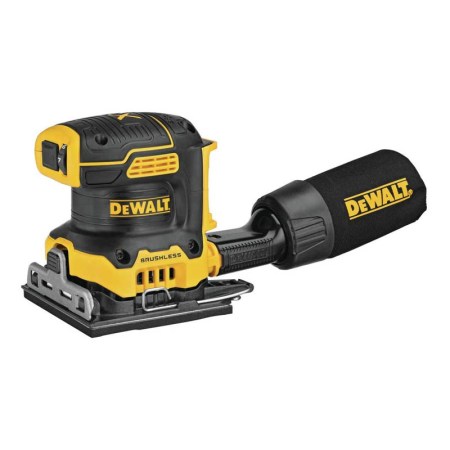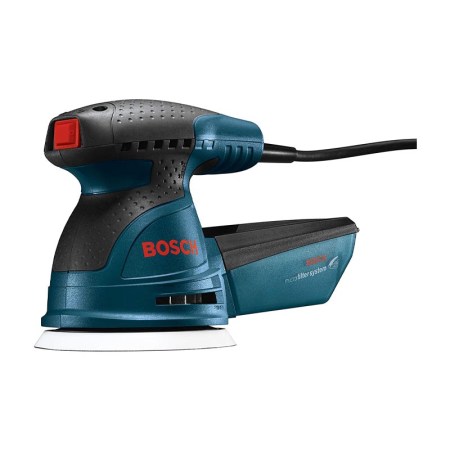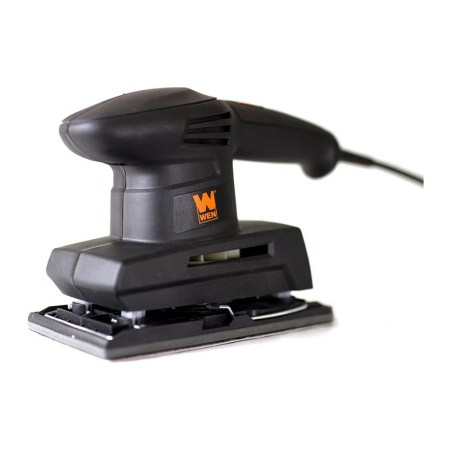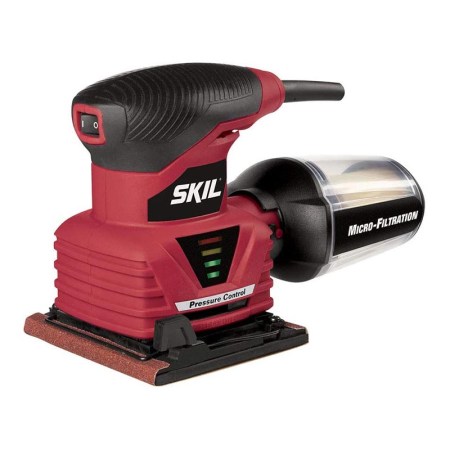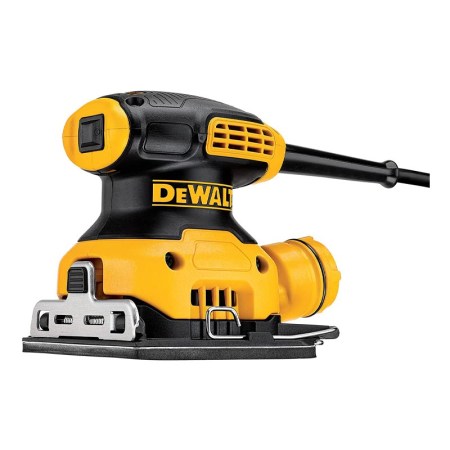We may earn revenue from the products available on this page and participate in affiliate programs. Learn More ›
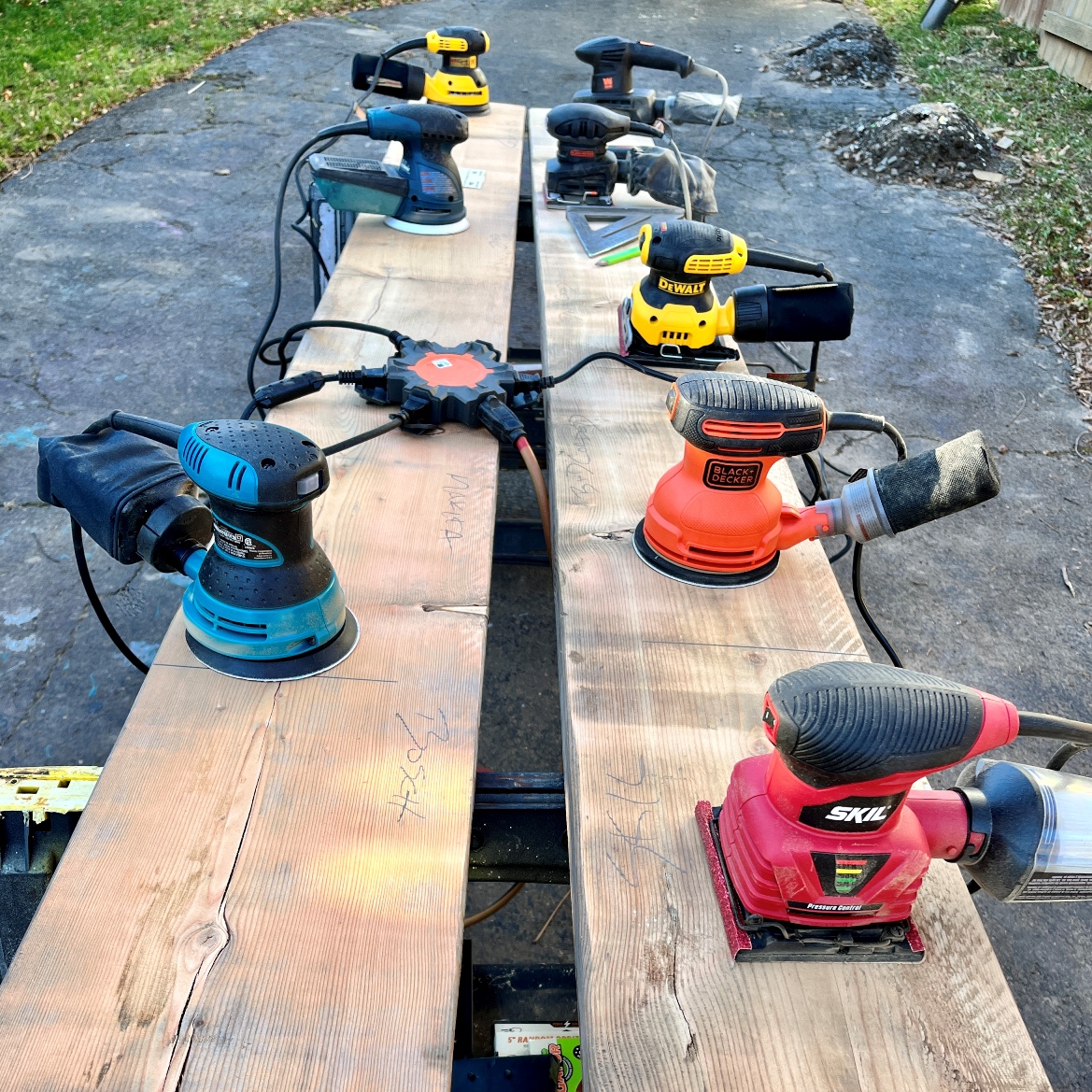
The finishing touches on a woodworking project can transform decent work into stunning craftsmanship. Using just the right sanding and finishing techniques can make all the difference. For this reason, some DIYers spend hours slowly sanding down wood projects by hand to achieve the perfect finish—a method that is time-consuming and tiring.
Whether the type of electric sander needed is a sheet sander or a random orbit sander, investing in the right kind of palm sander for your woodworking needs can help save both arm fatigue and time. Just attach a sandpaper to the bottom of a palm sander and the foot of the wood sander will vibrate rapidly in tiny orbits to efficiently sand down wood to a consistent finish, doing most of the work for the DIYer. Sanding can also open up the grain on a piece of wood so it accepts a finish coat more evenly.
Purchasing a high-quality palm sander machine is key to getting the woodworking results you want to achieve. We’ve researched and field-tested some of the most popular palm sanders on the market and narrowed the list to the following top-rated models in their individual categories.
- BEST OVERALL: Makita BO5030K 5-Inch Random Orbit Sander
- RUNNER-UP: DeWalt DWE6421 5-Inch Random Orbit Sander
- BEST BANG FOR THE BUCK: Black+Decker BDERO100 5-Inch Random Orbit Sander
- BEST CORDLESS SHEET SANDER: DeWalt 20V MAX XR Cordless Variable Speed Sander
- MOST COMFORTABLE: Bosch ROS20VSC 5-Inch Palm Random Orbit Sander
- MOST UNIQUE DESIGN: WEN 6313 Electric 1/3 Sheet Sander
- BEST ¼-SHEET SANDER: Skil 7292-02 ¼-Sheet Sander With Pressure Control
- BEST SHEET EXCHANGE: DeWalt DWE6411K ¼-Sheet Palm Grip Sander Kit
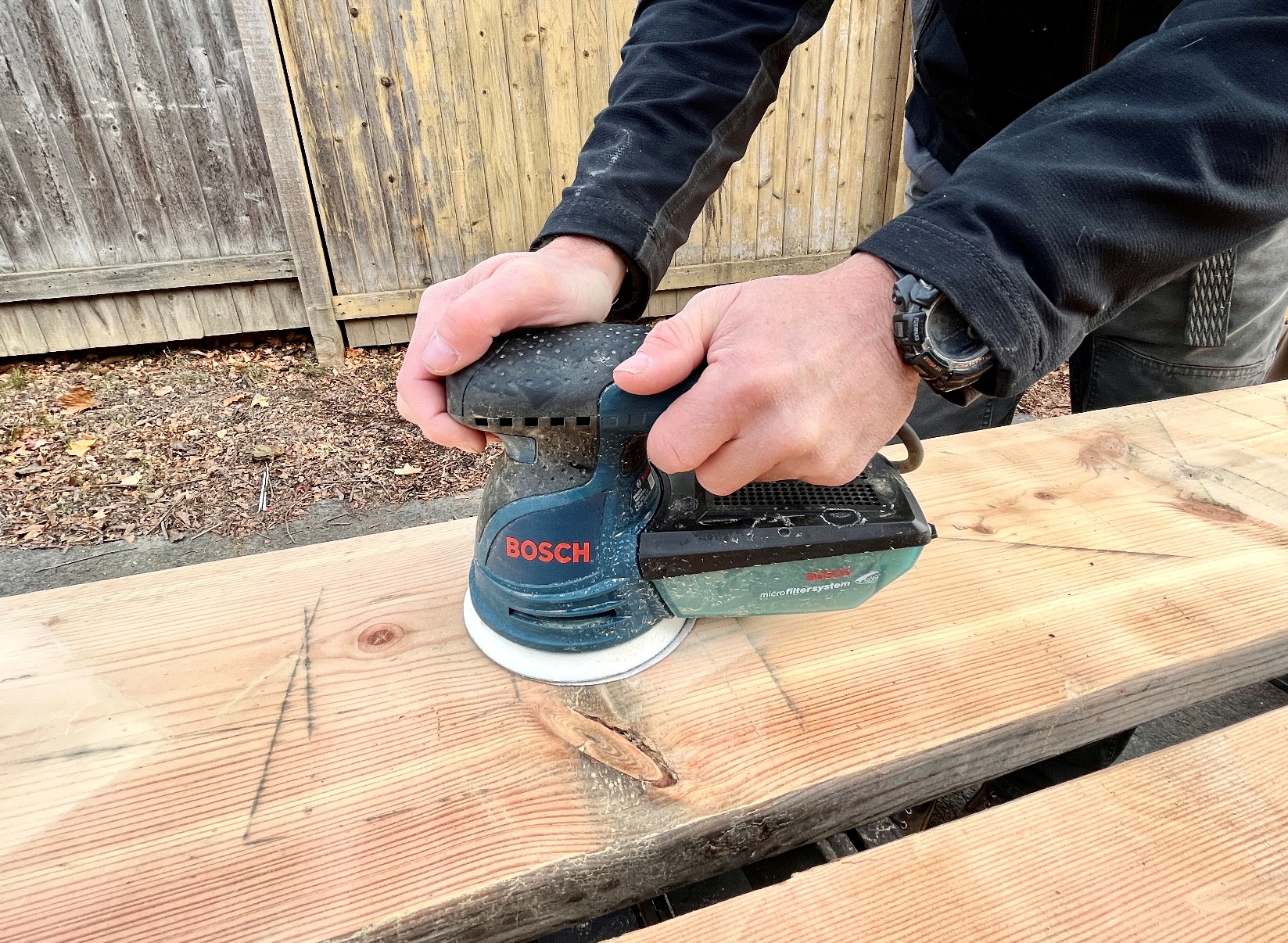
How We Tested the Best Palm Sanders
In order to get the widest array of uses in a single side-by-side power sander test—everything from bulk stock removal to detailing a surface—we chose to see how the tools performed on a beat-up, weather-stained Hem-Fir 2×10 that had been outside for a few months.
As we wanted to re-create typical use for these sanding tools, each sanding machine was used with three grits of sandpaper: rough (50-grit), medium (80-grit), and fine (120-grit).
- 50-grit sandpaper test: Evaluated stock removal and power in the mill marks and knots on the 2×10.
- 80-grit sandpaper test: Tested further stock removal and how each tool engaged with the piece of material.
- 120-grit sandpaper test: Determined how well each tool polished the material and opened the grain of the wood.
In addition to the performance of each tool, we evaluated the user’s experience. Cord length and flexibility, switches, paper exchange, smoothness, and comfort in use were also important criteria during our hands-on tests.
While sanding projects can look super smooth before finishing them, applying a finish can reveal swirl marks or blemishes the naked eye can’t pick up. We applied a finish to the wood to check that the sanded area was completely smooth before applying a finish to the main piece.
Our Top Picks
Although a sander’s primary function is to prepare a surface for a new finish, like removing the finish for a wood floor repair or even smoothing a hard-to-sand fast-setting joint compound on drywall, this collection of top picks includes both sheet sanders and random orbital sanders. Used in preparing bare wood for appearance and finish, the products below have been hands-on evaluated for stock removal, vibration, engagement with the project, and other important features. All these sanders left nice finishes and did their job for stock removal; the differences are in the details.
Best Overall
Makita BO5030K 5-Inch Random Orbit Sander
See ItThe Makita random orbit sander combines all the best features found in a tool in its category and is offered at a reasonable price. During our hands-on testing, we found that it has the power needed for stock removal, and it runs quietly and smoothly. The sander sends power and vibration into the work for stock removal without sending any back into the user.
The Makita sander’s body is tall and slender, making the sander easy to use for long jobs, and it has a decent cord length. It ships with a blow mold kit box for easy storage in the shop or on the truck. The dust bag is a little better than average, and the dust containment works well, too.
Product Specs
- Speed: 12,000 orbits per minute (opm)
- Power: 3 amps
- Cord: Corded
Pros
- Smooth operation creates a seamless finish easily; limited vibration allows for easy use.
- Powerful 12,000 opm motor can quickly manage most sanding tasks
- Quiet operating volume compared to similar options; should not disturb others during use in the home workshop
Cons
- Better-than-average dust bag still may not be suitable for heavy-duty use
Get the Makita orbital sander at The Home Depot or Acme Tools.
Runner-Up
DeWalt DWE6421 5-Inch Random Orbit Sander
See ItThe DeWalt random orbit sander delivers what’s needed from a sander. During our testing, we found that it has excellent stock removal and it leaves a nice finish. Its counterweight design reduces vibration for smooth operation, which is great for long jobs.
The sander has excellent engagement with the work, and it is easy to employ the switch. It’s a compact tool and has a small pommel, which may be an advantage to some users. The dust bag—held open by a spring—is much better than average and easy to dump out. The sander is simple and it works well. While it’s a little louder than other top picks, it’s hardly loud overall.
Product Specs
- Speed: 12,000 opm
- Power: 3 amps
- Cord: Corded
Pros
- Counterweight design reduces vibration for steady sanding and hands; won’t cause strain to wrists or hands
- Dust bags are easy to empty after use; simply twist off and empty
- Small pommel may suit some user preferences, and it’s particularly ideal for DIYers
Cons
- Louder than some other palm sanders in its category; may disturb others while in use
Get the DeWalt 5-inch palm sander at Amazon or The Home Depot.
Best Bang for the Buck
Black+Decker BDERO100 5-Inch Random Orbit Sander
See ItThe Black+Decker sander is ideal for occasional home-use jobs. The tool removes stock, runs smoothly enough, and won’t break the bank. Priced at less than half of some of the more pro-focused tools, we found that it also runs smoothly.
This sander’s switch is sealed and engages easily. It has a quality dust bag for a budget-friendly tool. It runs smoothly and despite having a lower rpm than others and no variable speed, we found that it can work on rough pieces, open the grain of a piece of stock to accept stain, or even sand a tough drywall repair.
Product Specs
- Speed: 12,000 opm
- Power: 2 amps
- Cord: Corded
Pros
- Affordable compared to other palm sanders on the market; comes with many of the same features but costs less
- Large dust bag for catching dust and debris; easy to empty after use
- Leaves a smooth finish quickly and easily; 12,000 opm power output creates a smooth finish
Cons
- Low power compared with similar options; may not be best for heavy-duty sanding
Get the Black+Decker palm sander at Amazon, The Home Depot, Acme Tools, or Target.
Best Cordless Sheet Sander
DeWalt 20V MAX XR Cordless Variable Speed Sander
See ItThe variable speed control of the DeWalt 20V Max XR palm sander allows the sander to be set as low as 8,000 opm for a fine finish or as high as 14,000 opm when extra power is needed. The cordless hand sander features a brushless motor that increases the life of the tool by decreasing the friction within the motor. The mobile design allows it to be used in the yard, in the workshop, or anywhere around the house without having to worry about dragging around an extension cord. The handy dust collector helps to keep a project clear of debris.
We found that the DeWalt cordless sander’s paper exchange is the best among the sanders tested, cordless or otherwise. The fact that it runs without a cord to move and that it runs smoothly and on par with its corded counterpart makes this a versatile sander. Add a nice switch and a variable speed dial and this DeWalt sander could find a home doing more work than just sanding woodworking projects, including sanding fast-set joint compound in a drywall repair on low-speed or detail sanding a floor repair. Battery exchange is easy, and the sander is nicely balanced.
Product Specs
- Speed: 8,000 to 14,000 opm
- Power: 20 volts
- Cord: Cordless
Pros
- Cordless operation allows for portability and ease of use; can be transported easily if needed
- Variable speed control is suitable for multiple sanding tasks; suitable for light to heavy sanding
- Excellent paper exchange; easy to change between soft and coarse sandpapers
Cons
- Costs more than corded tools; may be too expensive for some users
Get the DeWalt cordless palm sander at Amazon, Lowe’s, or Acme Tools (battery bundle included).
Most Comfortable
Bosch ROS20VSC 5-Inch Palm Random Orbit Sander
See ItThe Bosch random orbit sander delivered on all metrics during our hands-on testing. While it could be a bit grabby every now and again, it’s not enough of a reason to overlook its quiet, smooth, and comfortable operation. Most sanding is two-handed sanding, as one hand helps the other move the tool along the work, sanding out trouble spots. This tool’s larger pommel gives more surface area to fit two hands comfortably, making this tool the easiest for two-handed sanding among all the sanders tested.
The variable speed dial on the rear of the handle enables customizing the opm to the work. The unit performs well across the board, from stock removal to fine finishing. It has a top-notch, easy-to-install-and-remove hard-plastic dust container.
Product Specs
- Speed: 7,500 and 12,000 opm
- Power: 2.5 amps
- Cord: Corded
Pros
- Comfortable compared to similar options; will not cause fatigue while in operation
- Variable speed control allows for easy use during multiple sanding projects
- Outstanding dust-container design prevents dust and debris from floating in the air
Cons
- A little “grabby” from time to time when engaging the work
Get the Bosch palm sander at Amazon, The Home Depot, or Acme Tools.
Most Unique Design
Wen 6313 Electric 1/3-Sheet Sander
See ItWith a 1.2-amp motor that delivers up to 12,000 opm, the Wen Electric ⅓ Sheet Sander is powerful enough for tough projects despite weighing in at only 3 pounds. We found that the corded design and padded grip allow for long periods of comfortable working time without worrying about running out of power, while the integrated dust-collection bag minimizes sawdust and cuts down on cleanup time.
This dual-handled, ⅓-sheet tool is also fun to use. While it has a pommel like a typical palm sander and can be used as such, it also has a handle extension like a belt sander. The switch is super-easy to engage for “on” or ”off,” it runs reasonably smoothly, and is terrific for one- or two-handed operation. While it has easy-to-use stays for trapping ⅓ sheets of sandpaper, the pad is also hook and loop, making hook-and-loop paper an option. Overall, it delivered good stock removal, enough power, and comfortable operation.
Product Specs
- Speed: 12,000 opm
- Power: 1⅕ amps
- Cord: Corded
Pros
- Dual handles make for very comfortable operation and limited vibration
- Only peel-and-stick pad in our list of sheet sanders
- Biggest pad at ⅓ sheet; suitable for large sanding projects
Cons
- No hole punch for perforating paper; may not be suitable for some user preferences and needs
Get the Wen palm sander at Amazon, The Home Depot, or Lowe’s.
Best ¼-Sheet Sander
Skil 7292-02 ¼-Sheet Sander With Pressure Control
See ItDuring our hands-on testing, the micro-filtration system captured dust particles while sanding, keeping the surface of the project clean. With up to 14,000 opm, the Skil ¼-Sheet Palm Sander is powerful enough for tough projects, while the pressure-control system helps even the most inexperienced DIYer apply the correct amount of pressure for the job. The corded design and padded grip allow for long periods of comfortable working time without the user worrying about running out of power.
The tool doesn’t come with a punch to enable dust to pass (the user must punch the paper manually—not the end of the world) into its excellent dust container. Much better than a typical fabric bag, this hard, see-through plastic case with a filter enables the user to see when the case is full and doesn’t allow much dust to become airborne or spill as with typical bags. It has excellent stock removal and an easy-to-use switch.
Product Specs
- Speed: 14,000 opm
- Power: 2 amps
- Cord: Corded
Pros
- An excellent dust container prevents dust and debris from floating in the air
- Powerful compared to similar palm sander options available at speeds of 14,000 opm
- Built-in vacuum adapter for catching larger dust particles; keeps dust and debris out of the air during sanding
- Included paper punch for added user-friendliness; can be used with multiple paper types
Cons
- A little louder than the other palm sanders; may disturb others while in use
Get the Skil palm sander at Amazon or Acme Tools.
Best Sheet Exchange
DeWalt DWE6411K ¼-Sheet Palm Grip Sander Kit
See ItFor sites, shops, or jobs where sandpaper is changed out frequently, DeWalt’s system is far and away the best among those we tested. A simple release in front makes catching the paper super easy, trapping it in back with the wire holds quickly.
With top power for tough materials, the user can really lean on this tool for getting after difficult stock removal. The tool runs quietly, has a better-than-average dust bag, a built-in vac adapter for hooking directly to a vacuum without transition pieces, an included sheet punch, a great cord, and smooth operation. By design, the tool is compact for working in tight spaces.
Product Specs
- Speed: 14,000 opm
- Power: 2⅓ amps
- Cord: Corded
Pros
- Versatile and useful paper exchange for user-friendliness; compatible with many sandpaper options
- Plenty of power compared to similar palm sander products with speeds of 14,000 opm
- Quiet and smooth operation allows for little vibration while in use
- Useful, quality dust bag for catching dust and debris
Cons
- Compact by design; some users may want a larger tool
Get the DeWalt ¼-sheet palm sander at Amazon, Lowe’s, or Northern Tool + Equipment.
Jump to Our Top Picks
Types of Sanders
While all sanders that can be held in the palm of one hand are often lumped into a single category—palm sanders—they are two different tools that do the same type of work. Both sander types move sandpaper in an orbital fashion, or swirl, but do so differently. They also take two different types of sandpaper and deliver a different output of power and stock removal. While both are useful tools, choosing the wrong type of sander for a woodworking project can lead to problems and prevent achieving the desired results.
Sheet Sanders
The first category is called palm sanders, or sheet sanders. They’re typically compact tools that require the user to cut sheet sandpaper into rectangles, which are then held on the tool with retainer springs. These units move the sandpaper in a repeating orbit to wear away the grooves that the sandpaper grit leaves on the surface. For serious work, a palm sander is followed by a final hand-sanding with the grain of the material. These sanders are best for unfinished wood.
Random-Orbit Sanders
A random-orbit sander also swirls its platten (the part the sandpaper goes on,) but in a much more eccentric and random orbit, creating fine swirl marks that are harder to see. They also retain their paper with “hook and loop” (Velcro) rather than wire clips. Their heads are circular and they tend to leave a better finish. They also cost more.
While both types of sanders are often pitted against removing finishes—say, paint from a piece of furniture—finish removal of anything much beyond a layer or two of a hard urethane is an uphill battle for these tools. It’s not because they don’t have enough power; it’s because friction between the sandpaper and the finish creates heat. The heat melts and liquefies the finish, and that rapidly gums up the grit of the paper. Hand scraping often works best for several layers of finish removal.
What to Consider When Choosing the Best Palm Sander
Selecting the right palm sander depends on the project. Some of the most important characteristics of these tools include whether they are corded or battery-powered, the orbits per minute, and the dust-collection features.
Corded vs. Battery-Powered
Most power tools now come with these two options for their models: corded and battery-powered. Depending on available space, a corded sander can be effective and efficient, never running out of power or slowing to lower orbits per minute (opm) than needed. For projects in a basement workshop, a garage, or a shed, corded sanders tend to be the best option. Simply pair them with an extension cord and they can be used in any workshop space that has electricity.
Battery-powered sanders eliminate the need to manage a cord, which can get in the way on a workbench or a work table. A cordless sander can be easily used when the project is outdoors and away from accessible outlets. While these sanders can have issues with maintaining a set opm level if their battery gets low, spare batteries can solve this issue when they are switched at regular intervals. Cordless sanders also win out in terms of maneuverability. There is no need to sidestep cords to avoid tripping over them while working.
Orbits Per Minute
The bases of both a random-orbit sander and sheet sander move in tiny orbits. The slower the speed of the orbit, the cooler the sander and sandpaper will remain. However, the sander will also be slower and less aggressive at removing material. Faster orbits per minute (opm) will finish a project quicker but can also result in high temperatures that can damage heat-sensitive materials.
The best option for optimal control for any project is a palm sander with a variable speed setting. This will allow use of the sander in fine applications that require a slow opm or in more broad applications that would benefit from a faster opm.
Pressure Detection
Newer models of the palm sander are beginning to use pressure detection features to help avid DIYers achieve the pristine finish they’re looking for. These pressure detection systems work by displaying a gauge on the side of the sander that indicates the amount of pressure being applied. If the pressure becomes too great, a sensor light or a vibration alerts the user to ease up the amount of pressure.
Dust Collection
Sanding is a messy job that’s necessary for those who want certain projects or repairs to look as perfect as possible. While each unit can be hitched up to a vacuum, where they will sand more efficiently, dust-capture containers on some units have come a long way.
Even more important than the final finish of a project is the user’s health. Wearing a dust mask while working can prevent inhaling any dust and wood fibers that are being kicked up into the air, but a built-in dust collector can help to quickly remove irritating or harmful particulates from a project before they can become airborne.
Additional Features
Many sanders come with additional features that can make a sanding job easier. Since sanding can be a lengthy job, and working with a bulky sander can be tiring even after just a few minutes, one of the best features to look for in a palm sander is optimal ergonomic design.
Some manufacturers focus on the professional applications of palm sanders and design their tools with added protection against impact. This prevents the tool from taking a single knock and breaking. For those who frequently drop their tools or regularly toss them into the back of a work truck, consider choosing a palm sander from a professional brand.
Some woodworkers, finish carpenters, or DIYers who make items in the workshop may need a more robust sander with a professional brand’s features to get the smoothness of operation that is helpful during long-duration high-detail projects.
FAQs
Sanders are essential tools, even if they sit for long periods of time between uses. When sanding needs to be done, it needs to be done well. With two primary types of handheld sanders—random orbit and palm sheet sanders—figuring out which tool works best at which application can require some work.
Q. Is a palm sander or an orbital sander better?
A random orbit sander is regarded as being the better of the two tools. While the square pad on a palm sander may enable getting up close to something like an inside corner, random orbit sanders generally remove more stock. Plus, the randomness of their orbits are harder to detect in a finished piece and are less likely to telegraph through a finish.
Q. Is a sheet sander the same as a palm sander?
Yes, a sheet sander and a palm sander tend to be used interchangeably to describe the same tool that holds typical sandpaper to the tool with a wire clamp. It is unlike the hook-and-loop pads of random orbit sanders.
Q. What brand of palm sander is the most powerful?
All sanders are incredibly close as far as their capability for stock removal and finish. However, unscientifically, the Skil ¼-Sheet Palm Sander seemed to be the most aggressive at removing stock.
Why Trust Bob Vila
Bob Vila has been America’s Handyman since 1979. As the host of beloved and groundbreaking TV series including “This Old House” and “Bob Vila’s Home Again,” he popularized and became synonymous with “do-it-yourself” home improvement.
Over the course of his decades-long career, Bob Vila has helped millions of people build, renovate, repair, and live better each day—a tradition that continues today with expert yet accessible home advice. The Bob Vila team distills need-to-know information into project tutorials, maintenance guides, tool 101s, and more. These home and garden experts then thoroughly research, vet, and recommend products that support homeowners, renters, DIYers, and professionals in their to-do lists.
